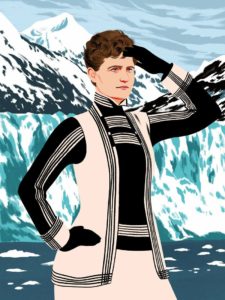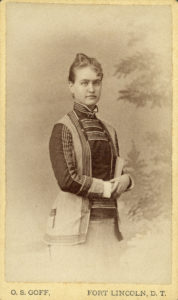Eliza Scidmore Sports a New Look

Eliza Scidmore by L.A. artist Bijou Karman (for online National Geographic)
On a research run through the Internet I come across this woodcut illustration of my book subject, Eliza Scidmore. It was made by an L.A. artist named Bijou Karman for an online National Geographic series on “21 Women Travelers Who Changed the World.”
You can see the list of women and their portraits here.
I recognized Scidmore at once because of what she’s wearing. The striking costume is from the original photograph this illustration is based on. There’s a copy of the original at the end of this post.
Seeing this gave me a moment of “research rapture” at knowing I’ve uncovered the details about exactly where and when the original photo was taken. Scidmore was about 20 at the time and working as a newspaper correspondent. (No, she wasn’t wearing this costume during her historic voyage to Glacier Bay.) There’s a fascinating story related to the trip she was on when the portrait was made. I’m saving the information, of course, for my book, which is now under contract to Oxford University Press.
Bijou Karman, the artist for the National Geographic woodcuts, graduated from the Art Center College of Design in 2014 with a BFA in illustration. She says her work “is inspired by nostalgia, strong women, plants and a love of print and bright colors.”
The women featured in the online series are very diverse, and they represent a long time span. I know a few of them and their published works:
- Isabella Bird
- Freya Stark
- Gertrude Bell
- Harriet Chalmers Adams
- Martha Gellhorn
- Nellie Bly
- Jan Morris
Harriet Chalmers Adams was one of the earliest female writers and photographers for National Geographic (around the early 1900s). Gertrude Bell is well known, of course, for her influence in the Middle East. I read one of the two major biographies of her. And every schoolkid knows the name Nellie Bly.
I was delighted to see Jan Morris on the list, as I’ve found several of her works great models for writing about place. Trieste and the Meaning of Nowhere (2001) is a small gem of a book.
Isabella Bird pops up often in my research for a biography of Eliza Scidmore because they traveled to many of the same places, sometimes missing each other by only a few years. They both wrote travel books on Japan and China. Their books on China were actually published at almost the same time (Bird’s in 1899, Scidmore’s in 1900). Scidmore even reviewed Bird’s China book for National Geographic.
While working on and off in Southeast Asia for a decade — in Indonesia, Malaysia and Singapore — I came across Isabella Bird’s name regularly in the context of her 1883 book The Golden Chersonese and the Way Thither. The title refers to the name that classical geographers used for the Golden Peninsula, or Malay Peninsula.
Both Bird and Scidmore traveled extensively in the American West. Bird published A Lady’s Life in the Rocky Mountains in 1879, at a time when Scidmore was writing travel letters from around the country for a newspaper in St. Louis.

Eliza Scidmore, as young reporter (Source: Wisconsin Historical Society)
I love the woodcut! I’m working on a children’s book about the cherry trees and am including Eliza. Congratulations on having your book under contract.
Hi, Natasha. I too love the woodcut art. You might also enjoy the local mural of Eliza Scidmore that I came across a few years ago at a hotel in D.C.
https://dianaparsell.com/2016/12/12/eliza-scidmore-wall-art-carlyle-hotel/
I look forward to seeing your book on the cherry trees. Do you have a due date?
Visited your website–what a great career and track record as a writer!
Best,
Diana